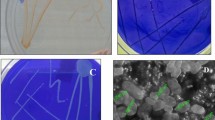Abstract
After analysis using HPLC and electronic ion spray mass spectroscopy, the purified siderophore produced by the marine-derived Aureobasidium pullulans HN6.2 was found to be fusigen. The purified desferric fusigen still had strong inhibition of growth of the pathogenic Vibrio anguillarum while the fusigen chelated by Fe3+ lost the ability to inhibit the growth of the pathogenic bacterium. The added iron in the medium repressed expression of the hydroxylase gene encoding ornithine N5-oxygenase that catalyzes the N5-hydroxylation of ornithine for the first step of siderophore biosynthesis in the yeast cells while expression of the hydroxylase gene in the yeast cells grown in the medium plus ornithine was enhanced.







Similar content being viewed by others
References
Actis LA, Fish W, Crosa JH, Kellerman K, Ellenberger SR, Hauser FM, Sanders-Loehr J (1986) Characterization of anguibactin, a novel siderophore from Vibrio anguillarum 775 (pJM1). J Bacteriol 167:57–65
An Z, Mei B, Yuan WM, Leong SA (1997) The distal GATA sequences of the sid1 promoter of Ustilago maydis mediate iron repression of siderophore production and interact directly with Urbs1, a GATA family transcription factor. EMBO J 16:1742–1750. doi:10.1093/emboj/16.7.1742
Atkin C, Neilands J, Phaff H (1970) Rhodotorulic acid from species of Leucosporidium, Rhodosporidium, Rhodotorula, Sporodiobolus, and Sporobolomyces and a new alanine-containing ferrichrome from Criptcoccus melibiosum. J Bacteriol 103:722–733
Baakza A, Vala AK, Dave BP, Dube HC (2004) A comparative study of siderophore production by fungi from marine and terrestrial habitats. J Exp Mar Biol Ecol 311:1–9. doi:10.1016/j.jembe.2003.12.028
Chi ZM, Wang F, Chi Z, Yue LX, Liu GL, Zhang T (2009) Bioproducts from Aureobasidium pullulans, a biotechnologically important yeast. Appl Microbiol Biotechnol 82:793–804. doi:10.1007/s00253-009-1882-2
Diekmann H, Zahner H (1967) Konstitution yon Fusigen and dessen Abbau zu Δ-2-Anhydromevalonsaurelacton. Eur J Biochem 3:213–218. doi:10.1111/j.1432-1033.1967.tb19518.x
Haas H (2003) Molecular genetics of fungal siderophore biosynthesis and uptake: the role of siderophores in iron uptake and storage. Appl Microbiol Biotechnol 62:316–330. doi:10.1007/s00253-003-1335-2
Haas H, Zadra I, Stoeffler G, Angermayr K (1999) The Aspergillus nidulans GATA factor SREA is involved in regulation of siderophore biosynthesis and control of iron uptake. J Biol Chem 19:1999–2006
Haselwandter K, Dobemigg B, Beck W, Jung G, Cansiert A, Winkelman G (1992) Isolation and identification of hydroxamate siderophores of ericoid mycorrhizal fungi. Biometals 5:51–56. doi:10.1007/BF01079698
Hossain MB, Jalal MAF, van der Helm D (1998) Gallium-complex of anguibactin, a siderophore from fish pathogen Vibrio anguillarum. J Chem Crystallogr 28:57–60. doi:10.1023/A:1021782703768
Jalal MAF, Hossain MB, van der Helm D, Sanders-Loehr J, Actis LA, Crosa JH (1989) Structure of anguibactin, a unique plasmid-related bacterial siderophore from the fish pathogen Vibrio anguillarum. J Am Chem Soc 111:292. doi:10.1021/ja00183a044
Johnson L (2008) Iron and siderophores in fungal–host interactions. Mycol Res 112:170–183. doi:10.1016/j.mycres.2007.11.012
Li JF, Chi ZM (2004) Siderophores from marine microorganisms and their applications. J Ocean Univ China 3:40–47. doi:10.1007/s11802-004-0006-y
Li CH, Song LS, Zhao JM, Zhu L, Zou HB, Zhang H, Wang ZH, Cai ZH (2007) Preliminary study on a potential antibacterial peptide derived from histone H2A in hemocytes of scallop Chlamys farreri. Fish Shellfish Immunol 22:663–672. doi:10.1016/j.fsi.2006.08.013
Li JF, Chi ZM, Li HF, Wang XH (2008) Characterization of a mutant of Alteromonas aurantia A18 and its application in mariculture. J Ocean Univ China 7:55–59. doi:10.1007/s11802-008-0055-8
Neilands JB (1984) Methodology of siderophores. Struct Bond (Berlin) 58:1–24
Renshaw JC, Robson GD, Trinci APJ, Wiebe MG, Livens FR, Colllison D, Taylor RJ (2002) Fungal siderophores: structures, functions and applications. Mycol Res 106:1123–1142. doi:10.1017/S0953756202006548
Riquelme M (1996) Fungal siderophores in plant–microbe interactions. Microbiol SEM 12:537–546
Sayer JM, Emery TF (1968) Structures of the naturally occurring hydroxamic acids, fusarinines A and B. Biochemistry 7:184–190. doi:10.1021/bi00841a023
Soengas RG, Anta C, Espada A, Paz V, Ares IR, Balado M, Rodriguez J, Lemosc ML, Jimenez C (2006) Structural characterization of vanchrobactin, a new catechol siderophore produced by the fish pathogen Vibrio anguillarum serotype O2. Tetrahedron Lett 47:7113–7116. doi:10.1016/j.tetlet.2006.07.104
Wang XH, Chi ZM, Li J (2007) Isolation and identification of a marine killer yeast strain YF07b and cloning of gene encoding the killer toxin from the yeast. Acta Oceanol Sin 26:101–109
Wang W, Chi ZM, Chi Z, Li J, Wang XH (2009) Siderophore production by the marine-derived Aureobasidium pullulans and its antimicrobial activity. Bioresour Technol 100:2639–2641. doi:10.1016/j.biortech.2008.12.010
Zhang FL, Chen JX, Chi ZM, Wu LF (2006) Expression and processing of Vibrio anguillarum zinc-metalloprotease in Escherichia coli. Arch Microbiol 186:11–20. doi:10.1007/s00203-006-0118-4
Zhou LW, Haas H, Marzluf GA (1998) Isolation and characterization of a new gene, sre, which encodes a GATA type regulatory protein that controls iron transport in Neurospora crassa. Mol Gen Genet 259:532–540. doi:10.1007/s004380050845
Acknowledgments
This work was supported by grant 30771645 from National Natural Science Foundation of China.
Author information
Authors and Affiliations
Corresponding author
Rights and permissions
About this article
Cite this article
Wang, W., Chi, Z., Liu, G. et al. Chemical and biological characterization of siderophore produced by the marine-derived Aureobasidium pullulans HN6.2 and its antibacterial activity. Biometals 22, 965–972 (2009). https://doi.org/10.1007/s10534-009-9248-x
Received:
Accepted:
Published:
Issue Date:
DOI: https://doi.org/10.1007/s10534-009-9248-x




